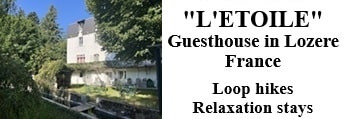Tourism in the city of Mende at the time |
Tourism in Mende at the beginning of the 20th century was primarily focused on discovering Lozère and its rugged natural landscapes. The city, often seen as a stopover rather than a major destination, attracted visitors eager to explore the Cévennes and Aubrac. The accommodation infrastructure was modest, mainly consisting of hotels and family-run guesthouses. The arrival of the railway had facilitated access, but the journey remained long, and the targeted audience was often a bourgeois elite in search of fresh air and thermal treatments, even though the city itself had no notable spring. Activities centered around walks in the surrounding countryside and visits to local historical monuments, such as the cathedral. It was a discreet form of tourism, far from the crowds of large seaside resorts, valuing the authenticity and tranquility of this rural prefecture.

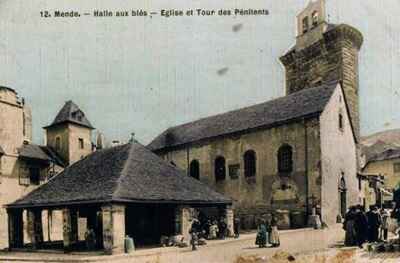 Place de Gaulle is the beating heart of the city, where the main roads converge. Whether arriving from the train station or Saint-Flour, you reach it by crossing the Lot over the Berlière bridge and taking the Piencourt alley, shaded by old poplar trees planted by the bishop who gave it its name (1707).
Place de Gaulle is the beating heart of the city, where the main roads converge. Whether arriving from the train station or Saint-Flour, you reach it by crossing the Lot over the Berlière bridge and taking the Piencourt alley, shaded by old poplar trees planted by the bishop who gave it its name (1707).
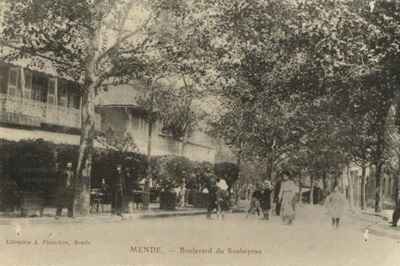 On this historic square, the monument to the Lozériens who died in 1870-71 bears witness to the region's tragic past. The town hall, built under Louis XVI, features simple yet harmonious architecture: a beautiful staircase, superb Aubusson tapestries in the council room, and a library rich in 13,000 volumes, including many incunabula.
On this historic square, the monument to the Lozériens who died in 1870-71 bears witness to the region's tragic past. The town hall, built under Louis XVI, features simple yet harmonious architecture: a beautiful staircase, superb Aubusson tapestries in the council room, and a library rich in 13,000 volumes, including many incunabula.
From Place de Gaulle, the circular boulevard, lined with plane trees, has taken the place of the old city moats. It begins to the southwest with Boulevard du Soubeyran, where the main cafés and the post office can be found. At the entrance of this boulevard, on the right, stands the Pénitents Tower, semi-cylindrical, the only remnant of the wall built in 1165 by Bishop Aldebert du Tournel. At the foot of this tower, the chapel of the Pénitents (1657) houses a black Virgin, an old copy of Notre-Dame-du-Puy. In the adjoining cloister, you can admire the insignia of the Pénitents' brotherhoods and a beautiful eagle lectern carved in wood from the late 17th century.
Nearby, Place au Blé opens onto the old town, which has retained all its past charm. The old houses reveal remarkable architectural details, and some streets have kept an archaic character. In Rue du Fournet, which departs to the left of the square, you can see doors from the 17th century and oratories with statues from the 15th century.
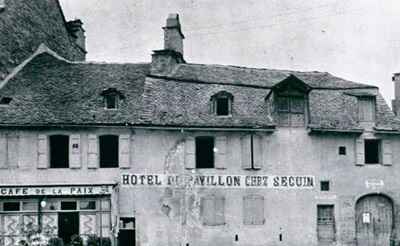 Boulevard du Soubeyran continues with Boulevard Henri-Bourrillon, leading to Place Urbain V, dominated by the facade of the cathedral. On this square, the bronze statue of Pope Urbain V, created by Dumont, pays tribute to the most illustrious of Lozériens (Guillaume Grimoard, born in 1309 at the castle of Grizac, near Pont-de-Montvert). To the left of the cathedral, the prefecture, in Louis XIII style, is a modern building.
Boulevard du Soubeyran continues with Boulevard Henri-Bourrillon, leading to Place Urbain V, dominated by the facade of the cathedral. On this square, the bronze statue of Pope Urbain V, created by Dumont, pays tribute to the most illustrious of Lozériens (Guillaume Grimoard, born in 1309 at the castle of Grizac, near Pont-de-Montvert). To the left of the cathedral, the prefecture, in Louis XIII style, is a modern building.
Saint-Pierre Cathedral was begun in 1369 by Pope Urbain V and completed in the 15th century after a 60-year interruption. It was destroyed by mining (1579) by the Protestants, who spared only the facade, the towers, and the choir. It was rebuilt from 1599 to 1620 with remarkable fidelity, but not without a certain austerity.
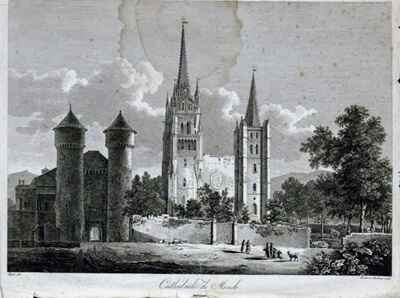 The facade, adorned with a beautiful rose window, is flanked by two beautiful towers built between 1508 and 1521 by Bishop François de la Rovère (whose coat of arms or initials can be seen in several places). The largest, on the left, very elegant, is 84 meters high and is decorated with buttresses and a Renaissance gallery. Its spire is accompanied by slight pinnacles. The right tower, simpler, is 65 meters high and has a small crocket spire. (To visit the grand bell tower, the sacristy, and the crypts, one must contact the sacristan).
The facade, adorned with a beautiful rose window, is flanked by two beautiful towers built between 1508 and 1521 by Bishop François de la Rovère (whose coat of arms or initials can be seen in several places). The largest, on the left, very elegant, is 84 meters high and is decorated with buttresses and a Renaissance gallery. Its spire is accompanied by slight pinnacles. The right tower, simpler, is 65 meters high and has a small crocket spire. (To visit the grand bell tower, the sacristy, and the crypts, one must contact the sacristan).
The nave, very simple, without a transept or triforium, is flanked by aisles and side chapels. The ambulatory surrounds the choir but contains only two radiating chapels.
The choir has stalls with woodwork from 1692 and panels depicting scenes from the life of Christ. On the main altar, one can see the miraculous statue of the black Virgin, already mentioned in the 13th century, precious relics, and beautiful wooden candelabra from the 17th century. At the back of the choir, an Assumption, a copy from the 18th century after Murillo, overlooks eight Aubusson tapestries dated 1706 and depicting the mysteries of the Virgin.
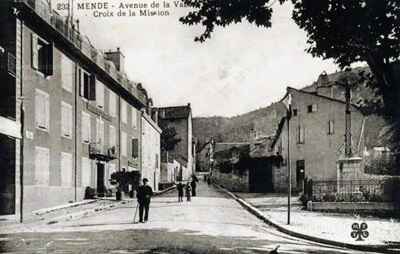 The pulpit, in Gothic style, is modern and made by the sculptor Pagès from Mende. Opposite is the episcopal stall Louis XIII and a beautiful wooden Christ from the 17th century that completes the decor. The woodwork of the great organs (from 1653) is also remarkable.
The pulpit, in Gothic style, is modern and made by the sculptor Pagès from Mende. Opposite is the episcopal stall Louis XIII and a beautiful wooden Christ from the 17th century that completes the decor. The woodwork of the great organs (from 1653) is also remarkable.
Behind the facade, one can see a tombstone from the 15th century and the clapper of the bell Marie-Thérèse or the Non-Pareille, which was cast in 1517 and destroyed in 1579 by Captain Merle. This bell weighed 460 quintals, and its clapper measures 2 meters 35 in height and 1 meter 10 in circumference at its widest point. In the side chapels, there are 15th-century fonts and several wooden altars in Louis XIV style. The baptismal chapel, to the left, is decorated with Renaissance woodwork featuring panels illustrating scenes from the Old Testament. The sacristy has a Renaissance-style door, a beautiful life-size wooden Christ from the 17th century, a modern gilded silver crozier, and a magnificent liturgical ornament composed of five pieces of brocaded silk from the 17th century.
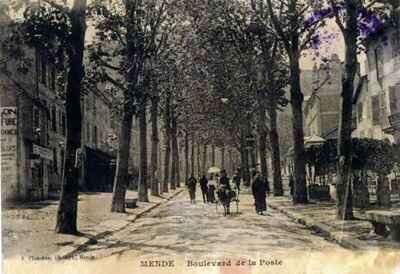 Near the clapper of the Non-Pareille, a flamboyant-style door leads to the grand bell tower (visit highly recommended; one can climb up to the fourth gallery or Clock gallery, 241 steps: breathtaking view of the old town and its vaulted roofs, cut by mansard roofs). Under the cathedral and at the foot of the grand bell tower, there are several crypts: the one housing the relics of Saint Privat dates back to the 12th century; it was discovered in 1905. The southern portal of the cathedral, which offers beautiful flamboyant decoration, opens onto Place Chaptal, embellished with a fountain. Beyond the courthouse, you find: to the left Rue de la Banque (road to Rodez), to the right Rue d’Aigues-Passes. Through Rue de la Banque and, to the left, Avenue du Musée, you can visit the museum of the Society of Letters, Sciences, and Arts of Lozère.
Near the clapper of the Non-Pareille, a flamboyant-style door leads to the grand bell tower (visit highly recommended; one can climb up to the fourth gallery or Clock gallery, 241 steps: breathtaking view of the old town and its vaulted roofs, cut by mansard roofs). Under the cathedral and at the foot of the grand bell tower, there are several crypts: the one housing the relics of Saint Privat dates back to the 12th century; it was discovered in 1905. The southern portal of the cathedral, which offers beautiful flamboyant decoration, opens onto Place Chaptal, embellished with a fountain. Beyond the courthouse, you find: to the left Rue de la Banque (road to Rodez), to the right Rue d’Aigues-Passes. Through Rue de la Banque and, to the left, Avenue du Musée, you can visit the museum of the Society of Letters, Sciences, and Arts of Lozère.
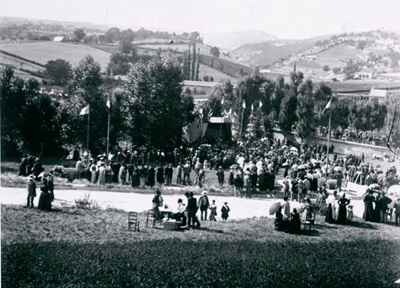 Here you discover the Bronze Age treasure found in Carnac, near La Malène, on the causse Méjean. You can also admire Christian cippes from Ispagnac and other places, Gallo-Roman trinkets, local coins, and stone fragments including beautiful reliefs from the 14th century from a tomb of the cathedral, and large cartouches from the 16th century bearing the arms of Bishop François de la Rovère. You can also contemplate works of art, minerals, and local birds, as well as a small collection of local lace. Take Rue d’Aigues-Passes, which offers ancient houses, one of which has a Gothic door with Renaissance panels. At the end of this street, turn left into Rue Notre-Dame, formerly known as Juiverie, the main artery of the old town; here you see a Gothic building, an old synagogue, and an oratory with a black Virgin placed above a fountain (modern paintings).
Here you discover the Bronze Age treasure found in Carnac, near La Malène, on the causse Méjean. You can also admire Christian cippes from Ispagnac and other places, Gallo-Roman trinkets, local coins, and stone fragments including beautiful reliefs from the 14th century from a tomb of the cathedral, and large cartouches from the 16th century bearing the arms of Bishop François de la Rovère. You can also contemplate works of art, minerals, and local birds, as well as a small collection of local lace. Take Rue d’Aigues-Passes, which offers ancient houses, one of which has a Gothic door with Renaissance panels. At the end of this street, turn left into Rue Notre-Dame, formerly known as Juiverie, the main artery of the old town; here you see a Gothic building, an old synagogue, and an oratory with a black Virgin placed above a fountain (modern paintings).
Further along, at the entrance of Rue du Collège, you pass a cross from the 16th century. Rue du Chastel extends Rue Notre-Dame: on the left, you see the remains of a fortified door that gave its name to the street, and on the right, an old stone cross. You arrive at Place du Chastel, where the monument of Senator Théophile Roussel stands.
 From Place du Chastel, through the alley Paul-Doumer and a street to the left, you reach the picturesque Notre-Dame de Peyrenc bridge from the 14th century, over the Lot: you cross it and turn right to admire it. By retracing your steps and continuing straight, you enter the old town where you take Rue du Collège to the left. To the right opens Rue de l’Epine where at No. 11, in a courtyard, the hotel de Ressouche from the 17th century in ruins: door from 1665, beautiful staircase. You emerge into Rue Droite, which leads back to Place de Gaulle, leaving to the left the picturesque fountain of Calguière.
From Place du Chastel, through the alley Paul-Doumer and a street to the left, you reach the picturesque Notre-Dame de Peyrenc bridge from the 14th century, over the Lot: you cross it and turn right to admire it. By retracing your steps and continuing straight, you enter the old town where you take Rue du Collège to the left. To the right opens Rue de l’Epine where at No. 11, in a courtyard, the hotel de Ressouche from the 17th century in ruins: door from 1665, beautiful staircase. You emerge into Rue Droite, which leads back to Place de Gaulle, leaving to the left the picturesque fountain of Calguière.
Surroundings of the city of Mende The Hermitage of Saint-Privat (890 meters). You take the boulevards to Foiral, where the path to Saint-Privat branches off to the right, winding up the mountain. You pass by the oratory of Saint-Ilpide, over graves discovered in 1805 and 1913; you enjoy a beautiful view of Mende. You follow the 14 small chapels of a Stations of the Cross. You arrive at the Hermitage of Saint-Privat, a popular pilgrimage site, partially carved into the rock and once inhabited by the holy bishop. Next to the chapel, you notice a curious resting place, carved from the rock.
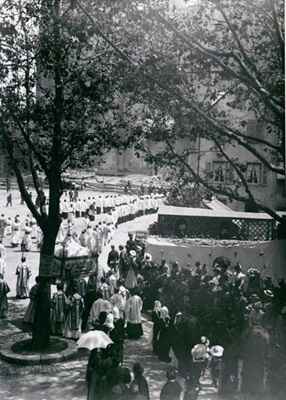 From the Hermitage of Saint-Privat, you can admire the large cross that overlooks the city of Mende and lights up at night. The view of Mende and its surroundings is splendid; the cathedral stands out proudly against the landscape. If you want to go to Croix de Mimat (1070 meters), you need to take a forest path to the right before the hermitage, which crosses plantations of black Austrian pines and reaches the edge of causse de Mende. At the summit, you are dazzled by the blooming lavenders in August. The panorama is impressive: you can see the cut of the Tarn, the causse of Mende and Sauveterre, Mont Lozère, the Roc plateau, and the Margeride mountains, and Aubrac in the distance.
From the Hermitage of Saint-Privat, you can admire the large cross that overlooks the city of Mende and lights up at night. The view of Mende and its surroundings is splendid; the cathedral stands out proudly against the landscape. If you want to go to Croix de Mimat (1070 meters), you need to take a forest path to the right before the hermitage, which crosses plantations of black Austrian pines and reaches the edge of causse de Mende. At the summit, you are dazzled by the blooming lavenders in August. The panorama is impressive: you can see the cut of the Tarn, the causse of Mende and Sauveterre, Mont Lozère, the Roc plateau, and the Margeride mountains, and Aubrac in the distance.
You can also explore the small causse of Mende, which stretches south of the hermitage. The Causse de Changefège. To get there, you follow the road to Florac until the railroad bridge (3 km), then take a right onto a cart path that leads up to the hamlet of Changefège (5 km); you discover a beautiful dolmen there.
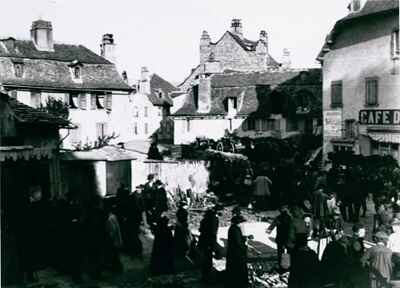 Lanuéjols and Bagnols-les-Bains. You leave Mende via the road to Florac and arrive at Rouffiac. You then leave Route N. 107 to take Route C. 41, which climbs up the Nize valley, between the small causse de Balduc, to the right, resembling a large reef, and the cliff of causse de Mende, to the left. Brenoux. You pass by the Château du Boy from the 18th century. Lanuéjols (857 meters): at the entrance to the village, to the right, you can see the remains of a Roman monument from the 3rd century, called “lou maselet” by the locals; it is a square of 5 meters 35 on each side, with niches 1 meter 30 deep and 2 meters 75 wide. The wall has a door topped with a lintel with an inscription indicating that it was a mausoleum dedicated to the memory of the children of Bassianus and his wife Regala.
Lanuéjols and Bagnols-les-Bains. You leave Mende via the road to Florac and arrive at Rouffiac. You then leave Route N. 107 to take Route C. 41, which climbs up the Nize valley, between the small causse de Balduc, to the right, resembling a large reef, and the cliff of causse de Mende, to the left. Brenoux. You pass by the Château du Boy from the 18th century. Lanuéjols (857 meters): at the entrance to the village, to the right, you can see the remains of a Roman monument from the 3rd century, called “lou maselet” by the locals; it is a square of 5 meters 35 on each side, with niches 1 meter 30 deep and 2 meters 75 wide. The wall has a door topped with a lintel with an inscription indicating that it was a mausoleum dedicated to the memory of the children of Bassianus and his wife Regala.
Many Gallo-Roman objects have been found around this monument. Lanuéjols has a beautiful Romanesque church. You can visit the ruined Château de la Prade and the Hermitage of Saint-Génies, where a plentiful spring emerges. After Lanuéjols, the road rises in turns to the pass of Masseguin or Loubière (1,185 meters), then descends to Bagnols-les-Bains. This is the circuit of Mont Lozère, which goes through Lanuéjols, Bagnols-les-Bains, Villefort, Le Bleymard, and Mende.
The Tarn Gorges and Aven Armand. You leave Mende via the road to Florac, then enter the Tarn Gorges, which offer spectacular landscapes. You cross Rozier, then arrive at Meyrueis, where you can visit Aven Armand, an underground cave with extraordinary stalactites and stalagmites. Instead of returning to Mende, you can continue the journey to Aigoual, and then to Nîmes, Montpellier, or Béziers. This text is extracted from the book “Cévennes, Languedoc: Rouergue, Albigeois, Causses, Gévaudan, Velay, Vivarais” by Jean Jacques Fauvel.
